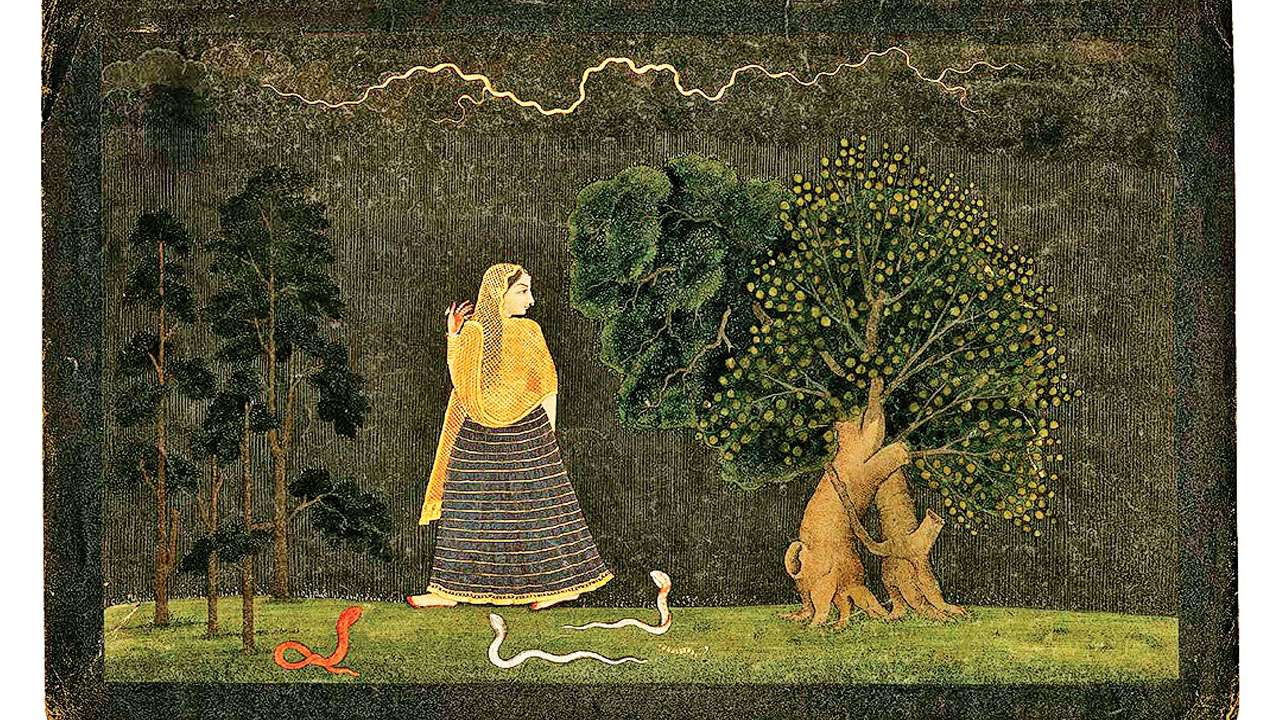
Barah Maah/ Twelve Seasons in Raag Tukhari (circa 15th century) by Guru Nanak is a composition replete with poetic splendour and a deeper recognition of nature as a guide/guru. Guru Nanak describes the twelve Indian seasons and against the changing landscape, foregrounds a woman lover, who suffers in birha/separation. The ancients in India had been practicing the genre of Barah Maah; Guru Nanak, however, adapted it allegorically towards a defined spiritual purpose.
Through the verses, there is an underlying rhythm that mimics the flow of changing seasons. And while seasonal changes are incremental and subtle, they attain their full glory too, in no uncertain terms. The poetic divisions correspond to the months of the lunar calendar. Beginning with the month of Chet (March-April)), it culminates in Phagun (Feb- March), revealing an evolved poetic idiom.
Ban phoole manjh baar/ Main pir ghar bahde (The forest blossoms right outside my door/ If only, my beloved would come home). Kokil amb suhavi bole/ kyun dukh ank saheeje (The koel sings sweetly on the mango trees/ pray, why, then this pain in the depths of my heart?)
In the description of each season, its characteristic markers are described and close attention paid to the description of foliage, flora and fauna. Change of season which proceeds in very subtle ways culminates in a characteristically vivid flowering. Spring gives way to blistering heat of summer:
Thal tape sar bhar/ The earth burns like a furnace (in Jeth )
Agan rassokhe…/ The fire dries up the moisture…(in Assad)
Bhi sokirt na hare/ And yet the sun does not grow tired
However, the rains rapturously wash down the heat and dust:
Saavan Saavansaras mana/ ghan varseh rut aaye
In saavan be happy, O mind/ the earth is washed anew with showers
The movement through seasons is mediated by a woman’s voice. In Gurbani, much like Sufi literature, a woman’s consciousness is equated with that of larger humanity. Her quest and sensual pining for a lover is transmuted into the larger quest for awareness/enlightenment.
The seasons change, the foliage undergoes numerous cycles marked by sprouting to flowering to decay, the orbs in the sky change position, the migratory birds descend and depart making a cacophony, days lengthen and shorten, all conceivable changes, captured with the exactitude of a dedicated observer and the timbre of a poet. This fidelity to detail fulfilled an important function in pre-photography days, besides illustrating an unwavering, devoted attention to nature that is almost meditative in quality.
While the portrait of seasons is itself a poetic gift, what we are invited to pay attention to, is the woman’s voice that remains constant. Further, her vulnerability in separation/birha is heightened with the changing seasons. She burns in the fire of separation and pines to meet the lover. Every season replenishes the desire anew. Every season heightens her sense of loss.
Barse nis kali/ kyun such baali/ dadar mor lavante
In dark nights, it rains incessantly/ how can the young bride find peace/ the frogs and peacocks make noisy calls
If left here, it would be love poetry of which birha is an oft-repeated strain. However, this quest transmutes into a spiritual one, where the lover is equated with God. The pain of separation, stems out of ignorance and attachment to duality. She evolves from a suffering lover figure to one who has overcome the throws of selfishness to acknowledge the grace of a larger love and in that, her quest finds a semblance of a resolution. The poem moves from a lingering restlessness to a deeper peace found in the realm of “true knowledge”. She discovers the inter relatedness of all creatures. Eventually, in Magh, the month of pilgrimage, she realises that the place of pilgrimage is within herself..
Nanak saw nature as the all-pervasive intelligence that held the answers to all the mysteries, however the path to revelation could only be attained through an assiduous observation. It is in this spirit of absorbed attention to nature that she transcends the limits of his flesh and conjoins with a larger energy that animates all existence. It is also the keen observation of a lover that takes her into the source spring of love’s mystery and revelations.
And if we are willing to rise above labels, this dialogue with nature could just be the thrust needed today for a more wholesome existence.
This is 550th Birth Anniversary year of Guru Nanak (1469- 1539)
Author is a teacher